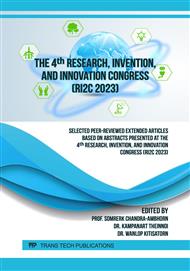[1]
Suwanpakpraek K., Patamaprohm B., Pornpeerakeat S., & Chaikittiratana A., Finite Element Implementation of the Exponential Drucker–Prager Plasticity Model for Adhesive Joints, CMES-Computer Modeling in Engineering & Sciences, 135(3), 2023.
DOI: 10.32604/cmes.2023.022523
Google Scholar
[2]
Stamoulis G., Carrère N., Cognard J. Y., Davies P., & Badulescu C., Investigating the fracture behavior of adhesively bonded metallic joints using the Arcan fixture, International Journal of Adhesion and Adhesives, 66, 147-159, 2016.
DOI: 10.1016/j.ijadhadh.2016.01.001
Google Scholar
[3]
Stratakis D., Performance of Aerospace Composites in the Presence of Process-Induced Defects, Cranfied University, 2017.
Google Scholar
[4]
V an Do, V. N., The behavior of ductile damage model on steel structure failure, Procedia engineering, 142, 26-33, 2016.
DOI: 10.1016/j.proeng.2016.02.009
Google Scholar
[5]
Arcan M., Hashin Z. A., & Voloshin A., A method to produce uniform plane-stress states with applications to fiber-reinforced materials, Experimental mechanics, 18(4), 141-146, 1978.
DOI: 10.1007/bf02324146
Google Scholar
[6]
Cognard J. Y., Davies P., Sohier L., & Créac'hcadec R., A study of the non-linear behaviour of adhesively-bonded composite assemblies, Composite Structures, 76(1-2), 34-46, 2006.
DOI: 10.1016/j.compstruct.2006.06.006
Google Scholar
[7]
Campilho R. D., Banea M. D., Pinto A. M., da Silva L. F., & De Jesus A. M. P., Strength prediction of single-and double-lap joints by standard and extended finite element modelling, International Journal of Adhesion and Adhesives, 31(5), 363-372, 2011.
DOI: 10.1016/j.ijadhadh.2010.09.008
Google Scholar
[8]
Dassault Systems, ABAQUS 2016: Theory manual, Dassault Systems, Rhode Island, USA, 2016.
Google Scholar
[9]
Suwanpakpraek K., Patamaprohm B., & Chaikittiratana A., Study of adhesive bonded joint failure in composite-metal joining. In IOP Conference Series: Materials Science and Engineering, Vol. 501, No. 1, p.012023, 2019.
DOI: 10.1088/1757-899x/501/1/012023
Google Scholar
[10]
Jousset P., Rachik M., Implementation, identification and validation of an elasto-plastic-damage model for the finite element simulation of structural bonded joints, International Journal of Adhesion and Adhesives, 50, 107-118, 2014.
DOI: 10.1016/j.ijadhadh.2014.01.020
Google Scholar
[11]
WAGNER, R. H. N. ABAQUS Tutorial: Damage for Ductile Metals–Material Model Explained–Ductile Damage, Project: ABAQUS–Material Model Explained–Video Series, 2021.
Google Scholar
[12]
ASTM, E8–99, et al, Standard test methods for tension testing of metallic materials, Annual book of ASTM standards, 2001.
Google Scholar
[13]
Bassery J., Renard J., Fatigue Delamination of Carbon Fiber Fabrics Reinforced PPS Laminates, Fatigue Behaviour of Fiber Reinforced Polymers: Experiments and Simulations, 195-222, 2012.
Google Scholar
[14]
Patamaprohm B, Phongphinittana E, Guinault C, Gantchenko V, Renard J, Jeandrau J P, Peyrac C and Lefebvre F, Study of adhesive joints under static and fatigue loading, Revue des composites et des matériaux avancés, 26, 63-85, 2016.
DOI: 10.3166/rcma.26.63-85
Google Scholar
[15]
Suwanpakpraek, K., Patamaprohm, B., Phongphinittana, E., Chaikittiratana, A., Experimental investigation and finite element modelling of the influence of hydrostatic pressure on adhesive joint failure, Materials Science and Engineering, 886(1), 012052, 2020.
DOI: 10.1088/1757-899x/886/1/012052
Google Scholar
[16]
American Society for Testing and Materials, Committee D14 on Adhesives, Standard Test Method for Apparent Shear Strength of Single-lap-joint Adhesively Bonded Metal Specimens by Tension Loading (metal-to-metal), ASTM international, 2005.
DOI: 10.1520/d1002
Google Scholar
[17]
Da Silva L F, Dillard D A, Blackman B and Adams R D, Testing adhesive joints: best practices, John Wiley & Sons, 2012.
DOI: 10.1002/9783527647026
Google Scholar
[18]
Jousset P., Rachik M., Implementation identification and validation of an elasto-plastic-damage model for the finite element simulation of structural bonded joints, International Journal of Adhesion and Adhesives, 50, 107-118, 2014.
DOI: 10.1016/j.ijadhadh.2014.01.020
Google Scholar
[19]
Stamoulis G., Carrère N., Cognard J. Y., Davies P., & Badulescu C, Investigating the fracture behavior of adhesively bonded metallic joints using the Arcan fixture, International Journal of Adhesion and Adhesives, 66, 147-159, 2016.
DOI: 10.1016/j.ijadhadh.2016.01.001
Google Scholar



